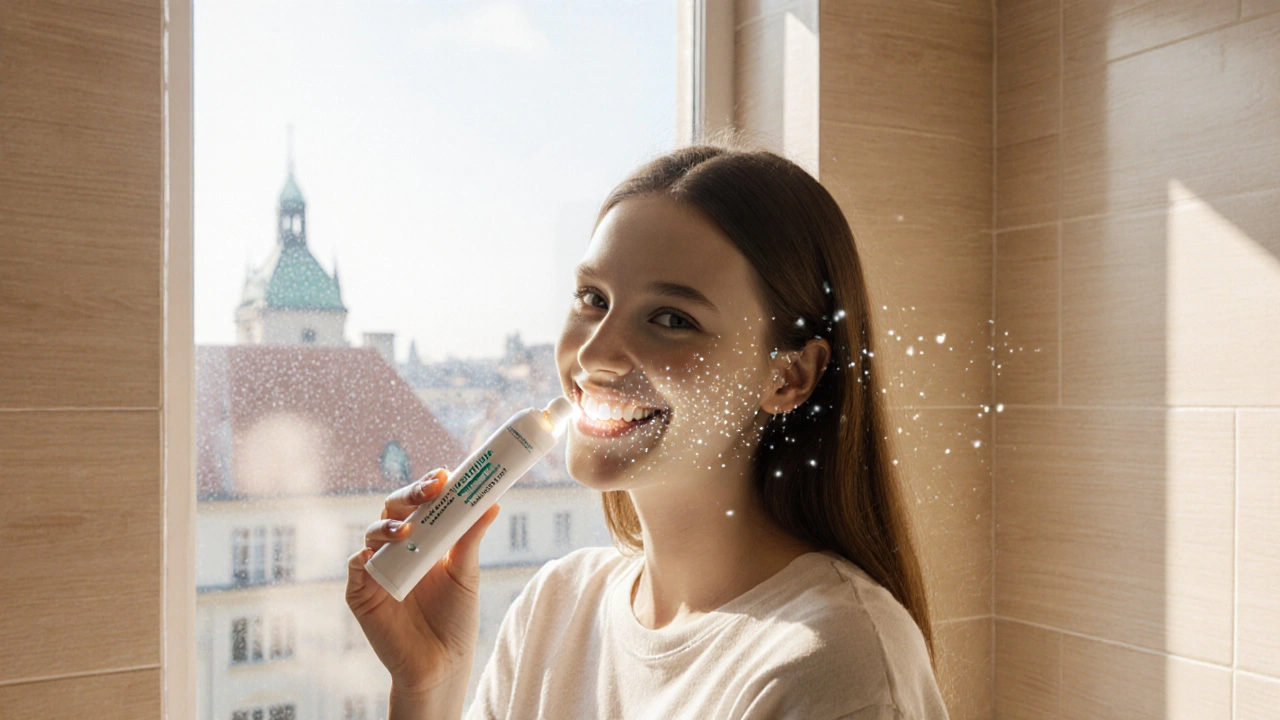Hydrogen peroxide – co potřebujete vědět
When talking about hydrogen peroxide, silný oxidační prostředek, který se v dentální praxi používá jako bělící činidlo i dezinfekční prostředek. Also known as H₂O₂, it plays a key role in modern bělení zubů a podporuje ústní hygienu. Proper use can reduce the risk of zubního kazu while improving smile aesthetics.
Hydrogen peroxide enables teeth whitening because its peroxide radicals break down pigment molecules on the enamel surface. This chemical action requires a controlled concentration – usually 3 % for over‑the‑counter rinses and up to 35 % for professional gels. The higher the concentration, the faster the color change, but also the higher the chance of sensitivity. That’s why dentists pair the agent with fluoride or potassium nitrate to protect dentin and keep the process comfortable.
Good oral hygiene supports the whitening effect. Brushing twice a day with a soft‑bristle brush, flossing, and using an antibacterial mouthwash remove plaque that would otherwise shield stains from the peroxide. When plaque persists, peroxide cannot reach the enamel, and the whitening results are uneven. Regular professional cleanings also eliminate tartar, creating a smoother surface for the bleaching agent to act on.
Preventing dental caries relies on the same hygiene habits. Hydrogen peroxide’s antibacterial properties kill Streptococcus mutans, the main culprit behind cavity formation. However, using peroxide alone does not replace fluoride, which remineralizes enamel. The best strategy combines daily brushing with fluoride toothpaste, occasional peroxide rinses, and balanced nutrition low in sugary snacks.
Praktické tipy pro bezpečné používání hydrogen peroxide
1. Vyberte si produkt s jasně uvedenou koncentrací. 3 % roztok je vhodný pro domácí ústní vodu, zatímco silnější gely by měly aplikovat pouze zubní lékaři.
2. Dodržujte dobu expozice – běžně 1–2 minuty u 3 % roztoku, maximálně 10 minut u profesionálních gelů.
3. Neaplikujte na poškozené nebo citlivé zuby bez konzultace s odborníkem – může to zhoršit dentinovou citlivost.
4. Po ošetření vždy doplňte fluoridovou pastu nebo ústní vodu, aby se zuby znovu posílily.
5. Pokud pociťujete bolest nebo nepříjemné pálení, přerušte používání a obraťte se na zubaře.
People often wonder whether hydrogen peroxide can replace traditional whitening strips. The answer is “no” – strips contain a calibrated dose of peroxide plus a gel matrix that stays in contact longer. Using peroxide rinses alongside strips can boost results, but over‑use may erode enamel. The safest approach is to follow a dentist‑guided schedule: professional bleaching sessions, then maintenance with low‑dose peroxide rinses every few weeks.
Another common question is whether peroxide harms the gums. In low concentrations, it is well‑tolerated; higher concentrations can cause irritation if the solution contacts soft tissue for too long. That’s why many at‑home kits include a protective gel barrier for the gums. If you notice redness or swelling, rinse the mouth with warm salt water and pause treatment.
Finally, remember that hydrogen peroxide is just one tool in a broader oral‑care toolbox. Combining it with proper brushing technique, interdental cleaning (mezizubní kartáčky), and regular dental check‑ups creates a comprehensive plan that keeps stains away, reduces plaque, and minimizes caries risk. Our collection of articles below dives deeper into each of these aspects – from cost‑effective tooth repair to tips for managing sensitive gums.
Projděte si naše články a najděte konkrétní rady, které vám pomohou využít hydrogen peroxide bezpečně a efektivně, ať už hledáte bělení, lepší hygienu nebo prevenci kazu.
Bělící zubní pasta - co vědět před koupí
Zjistěte, jak bělící zubní pasta funguje, na co se zaměřit při výběru a jak předejít nežádoucím vedlejším účinkům. Praktické tipy, srovnání produktů i často kladené otázky.
read more...
